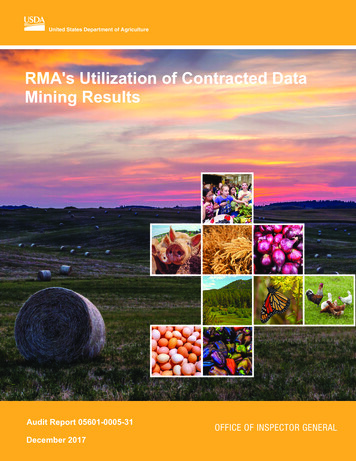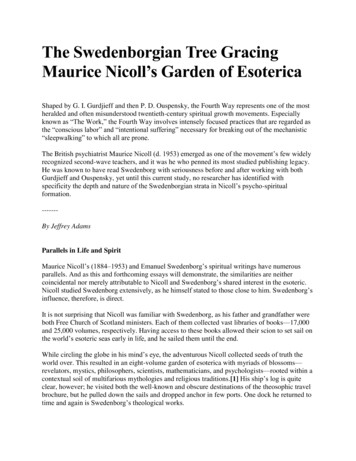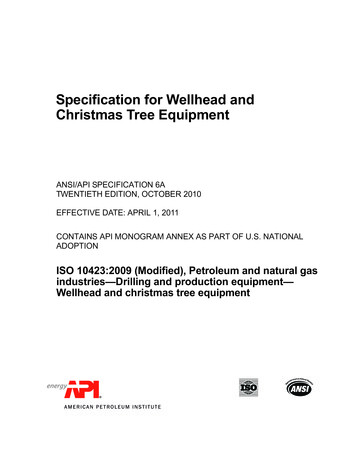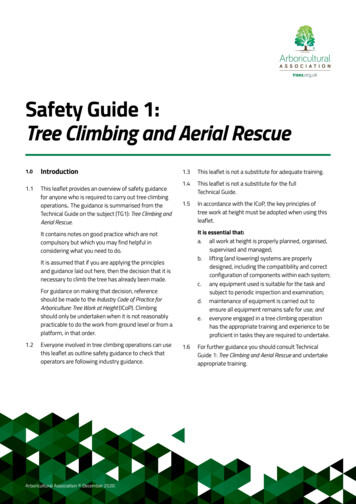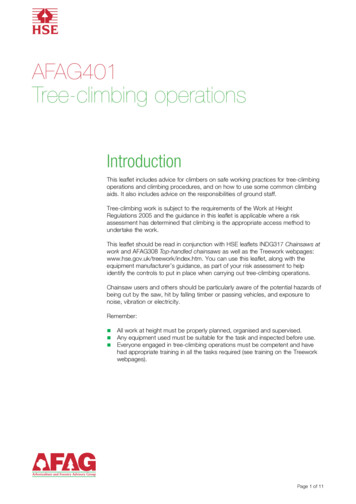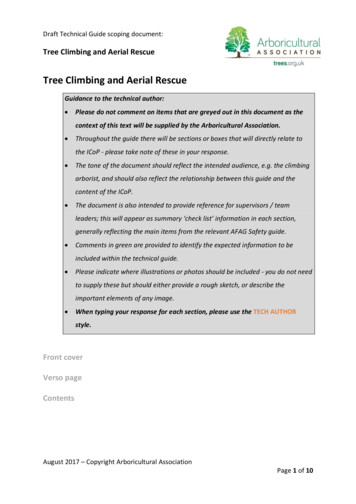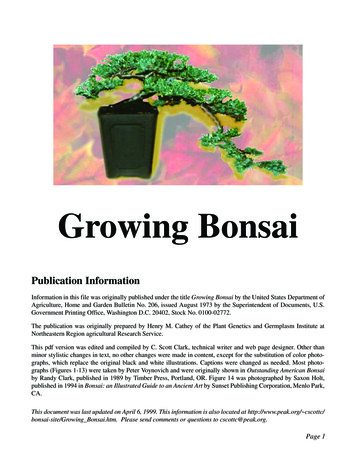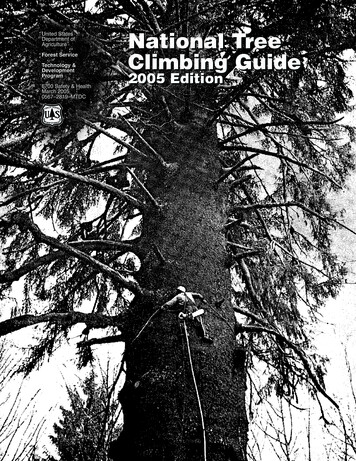
Transcription
United StatesDepartment ofAgricultureForest ServiceTechnology &DevelopmentProgram6700 Safety & HealthMarch 20050567–2819–MTDCNational TreeClimbing Guide2005 Edition
National TreeClimbing Guide20052005 EditionEditionDennis DavisProject LeaderUSDA Forest ServiceTechnology and Development ProgramMissoula, MTTE02H23—Technical ServicesMarch 2005The Forest Service, United States Department of Agriculture (USDA), has developed this information for the guidance of its employees, its contractors, and its cooperating Federal and State agencies, and is not responsible for the interpretation or use of this information by anyone except its ownemployees. The use of trade, firm, or corporation names in this document is for the information and convenience of the reader, and does not constitutean endorsement by the Department of any product or service to the exclusion of others that may be suitable.The U.S. Department of Agriculture (USDA) prohibits discrimination in all its programs and activities on the basis of race, color, national origin, sex,religion, age, disability, political beliefs, sexual orientation, or marital or family status. (Not all prohibited bases apply to all programs.) Persons with disabilities who require alternative means for communication of program information (Braille, large print, audiotape, etc.) should contact USDA’s TARGETCenter at (202) 720-2600 (voice and TDD).To file a complaint of discrimination, write USDA, Director, Office of Civil Rights, Room 326-W, Whitten Building, 1400 Independence Avenue, SW,Washington, D.C. 20250–9410, or call (202) 720-5964 (voice and TDD). USDA is an equal opportunity provider and employer.
AcknowledgmentsWe would like to acknowledge the Forest Service employees whose work has helped us produce theNational Tree Climbing Field Guide. Specifically, we would like to acknowledge:Jerry Berdeen, Dorena Genetic Resource Center, Umpqua National ForestBurnham Chamberlainø, Clackamas River Ranger District, Mt. Hood National ForestTyler Groo, Paulina Ranger District, Ochoco National ForestDale Kane, USDA Forest Service, retiredChuck McDonnell, Quinault Ranger District, Olympic National ForestDennis Ringnes, USDA Forest Service, Genetic Resource Center, Camino, CADonna Stubbs, Supervisor’s Office, Fremont National ForestRobert Walkowiak, Barlow Ranger District, Mt. Hood National Forest(writer and editor of the 1996 edition)ii
ContentsAcknowledgments . iiAbout the Project Leader . iv1. Introduction . 11.1 Training . 11.2 Physical and Mental Fitness . 11.3 Hazardous Duty Pay . 11.4 Obtaining Climbing Equipment . 11.5 Terms and Definitions . 12. Preparing for a Climb . 52.1 Basic Tree Climbing Equipment . 52.2 Working as a Team . 62.3 Checking for Hazards . 63. Ropes, Knots, Splicing, and Webbing . 113.1 Ropes. 113.2 Knots . 143.3 Whipping . 203.4 Splices . 203.5 Webbing . 204. Climbing Safety—Equipment, Systems, andProcedures . 234.1 Safety Equipment. 234.2 Safety Systems . 274.3 Safety Procedures . 344.4 Using Explosives in Trees . 354.5 Using Chain Saws in Trees . 365. Climbing Equipment—Use and Care . 395.1 Climbing Spurs. 395.2 Ladders . 425.3 Pole Steps. 455.4 Swiss Tree Grippers. 475.5 Ascenders . 495.6 Tree Steps . 556. Rappel Systems—Use and Care . 576.1 Rigging and Rappelling . 576.2 Sky Genie . 606.3 Figure-8 Descenders . 626.4 Rappel Rack . 656.5 Prusik System . 697. Rescue . 737.1 Rescue Equipment. 737.2 Rescue Procedures . 748. Equipment Specifications . 798.1 Carabiners and Screw Links . 798.2 Climbing Belts and Safety Harnesses. 798.3 Climbing Helmets . 79iii
Contents8.4 Ropes. 798.5 Webbing . 798.6 Miscellaneous Hardware. 799. Handling Materials and Tools While in Trees . 819.1 Pruning Branches . 819.2 Harvesting Seed . 829.3 Harvesting Scion Material for Grafting . 8210. References . 85About the Project LeaderDennis Davis is the specifications engineer for firefighting equipment with the Missoula Technology and Development Centerin Missoula, MT. He is a volunteer firefighter/emergency medical technician and a battalion chief for the Frenchtown Rural FireDepartment in Frenchtown, MT.iv
1. IntroductionClimbing and working in trees demands specializedequipment and skills. The potential for a seriousinjury or fatal fall is always present, so employeesshall be trained and certified before they engage in treeclimbing operations and activities. The Forest ServiceHealth and Safety Code Handbook and applicable State andFederal safety codes shall be followed.This guide has been produced and edited primarily by treeclimbers working in the Northwest coniferous forests. Everyattempt has been made to include comments from climbersin other parts of the United States as well as climbingtechniques for different types of trees. Some procedures andtechniques cited in this guide do not apply to some typesof tree climbing done by Forest Service employees. Eachjob assignment must begin with a job hazard analysis thataddresses the climbing dangers associated with the job,any unusual circumstances, and the employees’ plan forcompleting the task safely.1.1 TrainingWritten materials, like this guide, play an important role inacquiring knowledge of tree climbing techniques. But noamount of reading can make a person a safe, efficient treeclimber. That takes practice—practice under the guidance ofan experienced and competent instructor or certified climber.Study can prepare new climbers for their initial hands-ontraining or provide experienced climbers with a handy review.This guide will give you a basic understanding of theequipment and the tree climbing techniques you mustmaster to become a competent climber. The reference list inchapter 10 provides additional sources for increasing yourtree climbing knowledge.Climbers should review the equipment manufacturers’specifications and instructions for equipment care and use.Tree climbing assignments are accepted solely at thediscretion of the climber. He or she alone is responsible fordetermining the advisability of climbing a particular tree, in aparticular set of circumstances, on a particular day.Work supervisors should promptly withdraw a climber’scertification or remove the climber from climbing duties whenthe climber is physically or mentally unable to climb safely, has an unsound safety attitude, or has exhibited unsafe climbing habits.1. Introduction1.2 Physical and MentalFitnessTree climbing is arduous, demanding work that requiresupper body strength and overall flexibility. Besides beingphysically fit, you must be able to identify and compensatefor any physical or mental condition that might temporarilyimpact your climbing ability. Compensating may mean notclimbing until the condition is no longer a problem.1.3 Hazardous Duty PayTree climbing work can be hazardous and hazardous dutypay is appropriate as outlined in the Forest Service Manual.1.4 Obtaining ClimbingEquipmentWith a variety of commercial equipment available, it shouldnot be necessary to fabricate your own. Before buyingany equipment, check with your regional tree climbingcoordinator. Make sure equipment meets safety standardsand is suitable for the intended use. Buy only from reputabledealers familiar with the equipment and its construction,materials, and breaking strengths. Several such dealers areon Government contract. Chapter 10 of this guide contains alist of some equipment manufacturers and distributors.1.5 Terms and DefinitionsNomenclature associated with tree climbing and treeclimbing equipment includes a number of commonly usedterms. Sometimes, one term has several different meanings.To avoid confusion and possible climbing accidents, keyterms are defined:Field Guide Terms(Other Terms in Use)DefinitionsAnchor PointA secure point, usually another tree,used to secure the ropes used forclimbing or belay.Ascenders(Jumars, Gibbs)Any climbing device used to ascend avertically fixed rope. The termascenders usually refers tomechanical devices.1
1. IntroductionBelayCarabiner(Biners, LockingCarabiners)A method of protecting a climber incase of an accidental fall. A safetyrope tied to a climber is paid out ortaken in as the climber moves by asecond person (the belayer) or bythe climber in a self-belay (using the4-inch tie-in). By controlling the safetyrope, the belayer can stop the climberfrom falling.An oblong metal ring with a springloaded gate on one side used forvarious purposes in climbing, suchas attaching equipment to theclimber or securing the climber toa rappel system. Carabiners arenormally produced from bar stockthat is formed into the desired shape.Carabiners used in life-supportapplications shall be the self-closing,positive-locking type of carabiner.Chest HarnessStraps placed around the chest andshoulders only to secure the properpositioning for a chest attachmentpoint.Chicken LoopsSewn, tied, or buckled bands ofwebbing or rope that fit around theankle to prevent the ascender slingsfrom slipping off the climber’s foot.ClimberA person certified to climb a tree; theperson climbing.Climbers Belt(Linemans Belt,Body Belt,Safety Belt)A wide padded belt made of syntheticmaterial usually having two largemetal D-ring attachment points on thesides. A climbing belt does not havean attached chest harness.Climbing Harness(Safety Harness,Sky Genie Harness,Full Body Harness)A type of harness that provides bothpelvic and upper body support andcan be adjusted to fit individualclimbers. Climbing harnesses maybe a one-piece design (full bodyharness) or any two-piece designthat meets UIAA (Union Internationaldes Associations d’Alpinisme) orNFPA (National Fire ProtectionAssociation) standards. Climbingharnesses normally have separate legloops. Climbing harnesses should besuitable for rescue applications. Treeclimbing harnesses will usually haveall of the above plus two large D-ringattachment points on the sides.2Climbing HelmetDesigned specifically for climbing, thishelmet has a three-point chinstrapand is designed to remain in placeduring a fall. It is rated for the helmet’sability to protect against side andtop impacts. A hardhat is not anacceptable substitute.Climbing LineA rope used in tree climbing thatmay be used for ascending into atree, descending from a tree, and/orworking aloft in a tree.Climbing Spurs
This guide has been produced and edited primarily by tree climbers working in the Northwest coniferous forests. Every attempt has been made to include comments from climbers in other parts of the United States as well as climbing techniques for different types of trees. Some procedures and techniques cited in this guide do not apply to some types
